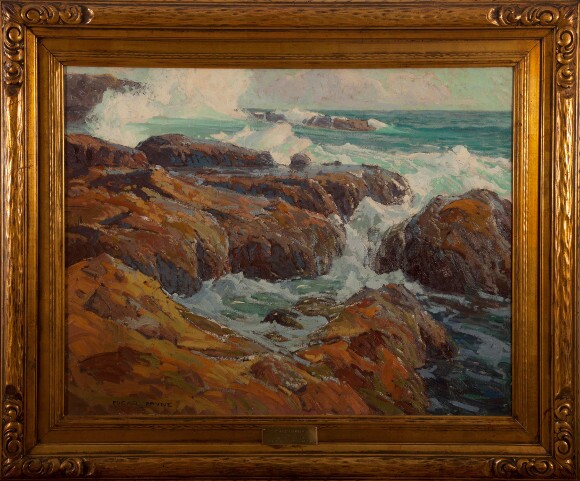How a South Bay High School Gained a Priceless Collection of California Impressionists

In Jean Mannheim's 1922 painting "Passing Ships," a young woman stares out towards the sea. Her blonde hair is mostly covered by a floppy hat. Her green shawl blows in the wind as her long, white dress rumples under her. The painting is part of the Autry's exhibition, "California Impressionism: The Gardena High School Collection," a provides a snapshot of the early years of our state. In the decades that follow, the outfits would shrink, but that notion of the California girl is here inside an impressionist painting that existed decades before surf songs and beach party movies did. Born in Germany, Mannheim set up his studio in Pasadena, where he became closely tied to the art community that developed in California during the early 1900s. "I like to think of this as the beginning of California's modern identity as this relaxed, elegant, attractive place," says Amy Scott, chief curator at the Autry National Center.

While the exhibition explores West Coast Impressionism, which manifests here primarily in breathtaking images of California's diverse geography, it is surprising to learn that the paintings in this show are on loan from a local high school. "Passing Ships" was acquired by the Gardena High School Library in 1928. Other pieces of the collection, from renowned artists like Edgar Payne, Maynard Dixon and others, were purchased by senior classes as part of a tradition that lasted for more than 30 years.
The acquisitions started in 1919, when the school's principal, John Whitely, suggested that graduating students give the gift of art to the school. As successive classes took on the task of art-buying, they went on studio visits, held discussions and votes to select the pieces and raised funds for the purchases. Faculty and community members became involved in the project as well. This continued until 1956. In that time, Gardena High School garnered a healthy collection of art. Ultimately, not all of the pieces survived and some still need to be preserved.

For a little more than a decade, the Autry has been caring for 15 pieces from the high school's collection, among them the nine that appear in "California Impressionism." Scott first heard about the collection in 2000, after she began working at the Autry. Four years later, she was able to get a fraction of the surfing collection, basically the amount the museum had space to store, on loan. "I was just lured in by the story," she says, "by the quality of art, which is glorious, especially post-cleaning." Scott also wanted to give the works a space where larger audiences could view them.
It was a mutually beneficial loan. Not only could the Autry help out Gardena High School, but the school helped the museum expand its offerings. "We didn't have much by the way of California painting, early 20th century," says Scott. "It allows us to integrate that story, the California Impressionist story, into the way we talk about art and the American West."

On a recent walk through, Scott points out the significance of each piece. There is "California Hills" by Maurice Braun, who lived in San Diego. "It's an undramatic landscape," she says, "which is different from the way that artists portrayed California in the 19th century." She says that's part of the appeal of Braun's work, as well as that of other California Impressionists. "It made the place and the land accessible," she explains of the paintings.
The ocean, of course, is popular subject matter for these painters as well. Scott points to "Head Winds (Storm at Sea)" by Joe Duncan Gleason as an example of a Pacific painting that was a bit out of the ordinary. "I like this because it shows men at work on this big schooner trying to reel in one of the sails," she says. "Most California impressionists veered away from labor and the less glamorous side of California's history in the shipping industry, but Gleason did not. This is just a great scene of the muscle and the hard work required in that."

In eight of the works in this collection, the artists take viewers on a trek across the state, from the beach to the desert with a stop in the Sierra Nevada mountains. After that, the show heads across state lines in what Scott considers to be the most important painting in the exhibition.
Although a native of California, Maynard Dixon's work explored the Southwest at large and in "Men of Red Earth" he depicts two Native American men looking into the distance. Scott explains that this painting was inspired by travels through Arizona and New Mexico in the early 1930s and was repainted later. It was purchased by Gardena High School's Class of Summer 1944. She says that this painting is indicative of the interests that Dixon, who leaned towards Impressionism earlier in his career, had in modernism and Native American culture. "I don't know how they chose this painting," says Scott. "Because it was more modern than the rest of the collection and because it was not California, I think it represents one of the more ambitious choices."
That's part of what makes this collection so unusual. Gardena was not the only school that collected art, but the institution did it extremely well. "I think that other schools did make the effort, but, for whatever reason, Gardena's was the most serious," she says. "It was the most significant and it was the one that has stood the test of time and by far the best."


Dig this story? Sign up for our newsletter to get unique arts & culture stories and videos from across Southern California in your inbox. Also, follow Artbound on Facebook, Twitter, and Youtube.


